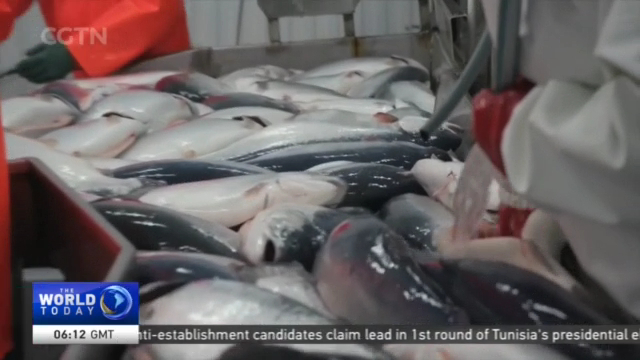
14:44, 16-Sep-2019
Russian Seafood Trade: Producers increasingly favor Chinese market
Updated
15:19, 16-Sep-2019

With its vast coastline, Russia aims to increase the production of farmed fish and seafood. It hopes to produce enough for its domestic market and also to export, with China being an obvious choice. Our correspondent Aljosa Milenkovic visited one of the farms in the Barents Sea and filed this report.
A catamaran is fighting its way through the rough Barents sea, just outside of Kola Bay.
It's heading from Murmansk to the largest sea farm platform close to Kildin island. Almost three million salmon are grown here in the cold and pristine waters.
NIKITA PADERIN, DEPUTY CEO RUSSIAN AQUACULTURE "Every net cage contains between 150 and 170 thousand salmon. The cage goes 20 meters below the surface, and the fish there are perfectly free. They're in the same water and the same environment as the wild fish."
Russians here are learning from Norwegians how to farm salmon. And they hope that combining that experience with a clean natural environment, they can produce outstanding products.
DANIIL POLOVINKA, DEPUTY CEO FAR EASTERN INVESTMENT AND EXPORT AGENCY "It's an ecologically clean product. This is especially good because Russia has established that image in the markets of regional consumers. Due to the relatively small population and clean nature, our products are eco-clean. And in Asian countries, seafood is literally grown in sewage."
It is Asian consumers they are aiming at. Salmon prices there are higher than anywhere, making it the most attractive market in the world.
ILYA SOSNOV, CEO RUSSIAN AQUACULTURE "In the long term, strategically, China is also a very important market for us, because it is close to Russia, there is a railway connection between Russia and China. And, consumption of salmon in China is expected to rise several times. So this is the place to be, and we want to be in China."
But that plan comes with a catch.
ALIJOSA MILENKOVIC KILDIN ISLAND IN THE BARENTS SEA "Even from Soviet-era times, Russia has struggled to produce enough fish and seafood to satisfy its own needs. With Chinese investment in the Far East of the country and some domestic efforts, producers hope to at least narrow the gap."
And yet, the local producers are saying that it is economically viable for them to export part of their production to China.
It'll bring them more opportunities to achieve higher profits, and at the same time to supply China with the products that are in demand there.
Just recently, the first test delivery was sent from this farm to China, and more are expected to follow.
Aljosa Milenkovic, CGTN, Kildin Strait in the Barents Sea.
SITEMAP
Copyright © 2018 CGTN. Beijing ICP prepared NO.16065310-3
Copyright © 2018 CGTN. Beijing ICP prepared NO.16065310-3